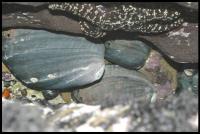
A rare occurrence in Southern California-black abalone cluster together in a rocky, intertidal crag on San Nicolas Island. NOAA Fisheries Service published with the Federal Register today a proposed rule to list black abalone, a marine mollusk coveted by fishermen and gourmets alike, as endangered under the Endangered Species Act (ESA). The proposal comes after NOAA Fisheries Service considered the report of a scientific review team concluding that the species is at risk of extinction.
“The scientific review team reported major declines in the population of black abalone, especially in the areas around the Channel Islands off Southern California,” said Rod McInnis, Southwest Regional Administrator for NOAA’s National Marine Fisheries Service. “These proposed regulations seek federal protection for black abalone and request input from the public in determining what areas might be included as critical habitat for the species.”
Black abalone were once plentiful in the intertidal waters from Northern Baja California, Mexico, to Monterey, Calif., although there is some scientific debate about how far north the population once extended. The species was utilized by early California natives and peaked as a commercial fishery in the state in 1973 with almost two million pounds harvested.
Since the 1980s, black abalone abundance has plummeted primarily from a bacterial disease known as withering syndrome. Other causes of the rapid population decline are likely due to historical overfishing, poaching and natural predation. NMFS has considered recent preliminary evidence which suggests a small disease resistant population may exist at San Nicolas Island. Even with this possibility, the likelihood that black abalone populations will continue to decline towards extinction (within the next 30 years) is very high.
Source : NOAA National Marine Fisheries Service
 Print Article
Print Article Mail to a Friend
Mail to a Friend
